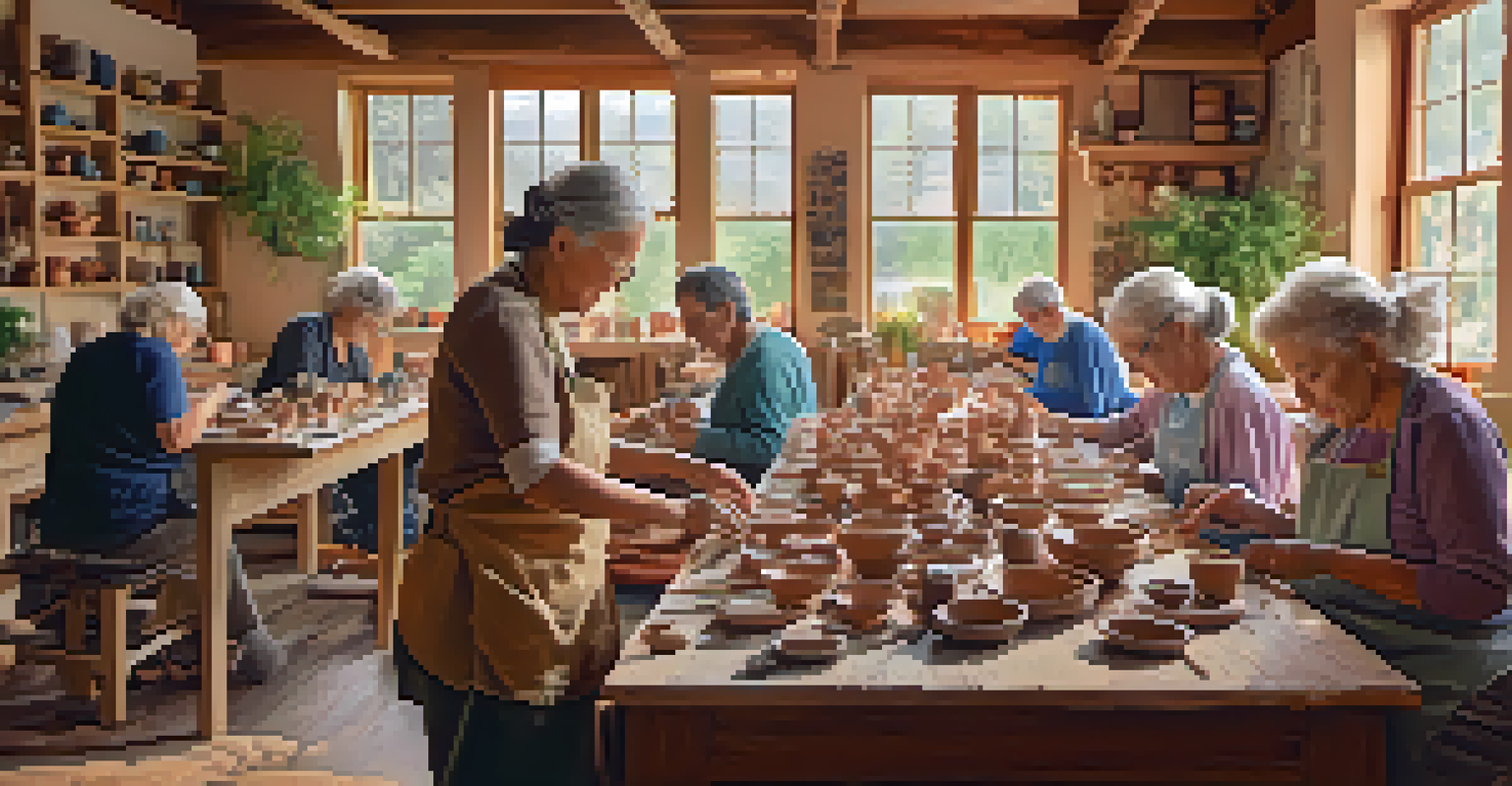The Significance of Art in Senior Living Environments

Art Fosters Connection Among Seniors
Art serves as a powerful medium for connection in senior living environments. It provides a common ground for residents to share experiences and bond over their interpretations of various artworks. Whether it's a painting, a sculpture, or a community mural, these artistic expressions can spark conversations, breaking the ice for residents who might otherwise feel isolated.
Art enables us to find ourselves and lose ourselves at the same time.
For instance, a group of seniors might come together to discuss a vibrant landscape painting, sharing their own memories tied to similar scenes. This interaction not only enhances socialization but also nurtures friendships, creating a more harmonious community. In essence, art becomes a bridge that brings people together.
Furthermore, collaborative art projects can deepen these connections, as residents work side by side to create something meaningful. This teamwork not only fosters camaraderie but also instills a sense of accomplishment and pride in their collective effort.
Art as a Tool for Self-Expression
In senior living settings, art allows individuals to express themselves in ways they may not have previously explored. Whether through painting, drawing, or crafting, seniors can communicate their feelings, stories, and identities creatively. This form of self-expression can be particularly therapeutic, providing an outlet for emotions that may otherwise be difficult to articulate.

Imagine a senior who has always loved painting but never had the time to pursue it. In a supportive living environment that encourages artistic endeavors, they can rediscover this passion and express their life experiences through their artwork. This not only boosts their confidence but also reaffirms their identity as an artist.
Art Builds Connections Among Seniors
Art serves as a powerful medium for seniors to bond, share experiences, and nurture friendships.
Moreover, engaging in art can lead to personal reflection, allowing seniors to process their past and present. This reflective practice can foster a greater sense of self-awareness, helping them navigate the complexities of aging with grace.
Art Enhances Cognitive Function and Memory
Participating in art activities can significantly boost cognitive function among seniors. Engaging with art stimulates the brain, encouraging active thinking and creativity. Activities like painting or sculpture require focus and problem-solving, which can help keep the mind sharp.
Every artist was first an amateur.
For instance, seniors involved in art programs often demonstrate improved memory recall and enhanced mental agility. They might find themselves reminiscing about past experiences while creating, which serves to strengthen neural connections, essential for maintaining mental health.
Additionally, art can be particularly beneficial for those experiencing memory loss or cognitive decline. Familiar themes in art can evoke memories, sparking joy and recognition, which can be incredibly uplifting for both the individual and their caregivers.
Art Provides Therapeutic Benefits
Art therapy has gained recognition for its therapeutic benefits, particularly in senior living environments. This form of therapy encourages creativity as a means of coping with emotional or psychological challenges. It can be particularly effective for seniors dealing with grief, depression, or anxiety, providing a safe space to express their feelings.
Engaging in artistic activities can promote relaxation and reduce stress levels. The act of creating—whether through painting, pottery, or music—can serve as a meditative process, helping seniors focus on the present moment and alleviate worries.
Art Enhances Cognitive Abilities
Engaging in art activities stimulates the brain, improving memory recall and mental agility among seniors.
Moreover, art therapy sessions led by trained professionals can offer structured support, guiding seniors through their creative journey. This not only enhances their artistic skills but also fosters a sense of community and shared understanding among participants.
Art Beautifies Living Spaces
Incorporating art into senior living environments can transform the aesthetic appeal of these spaces. Thoughtfully chosen artworks can uplift the atmosphere, making common areas feel more inviting and vibrant. A well-decorated environment can significantly enhance the overall quality of life for residents.
Consider a bright, large mural in a shared dining area; it not only serves as a conversation starter but also creates a warm, welcoming ambiance. Art can also reflect the culture and history of the residents, fostering a sense of pride and belonging within the community.
Furthermore, personalized artistic touches, such as resident-created art, can enhance the emotional connection residents feel to their environment. When seniors see their own or their peers' work displayed, it reinforces a sense of ownership and pride in their living space.
Art Encourages Lifelong Learning
Art provides an excellent opportunity for lifelong learning among seniors. Participating in art classes or workshops allows residents to acquire new skills and knowledge, keeping their minds engaged and active. This commitment to learning can invigorate their daily lives and maintain their sense of curiosity.
For example, a pottery class might introduce seniors to new techniques, sparking interest in materials and tools they have never used before. This not only enhances their artistic repertoire but also fosters a sense of achievement as they master new skills.
Art Encourages Lifelong Learning
Participating in art classes allows seniors to acquire new skills and rediscover passions, enriching their lives.
Moreover, the act of learning itself can be a source of joy and purpose. As seniors explore different art forms, they may find new passions or rediscover old ones, enriching their lives in ways they hadn't anticipated.
Art Promotes Cultural Understanding
Art is a universal language that transcends cultural boundaries. In senior living environments, showcasing diverse forms of art can promote understanding and appreciation of various cultures. This exposure can enhance the community's sense of inclusivity and belonging.
For instance, art exhibits featuring works from different cultures can encourage discussions and learning among residents. Sharing stories about cultural traditions and artistic practices fosters a deeper connection among seniors, enriching their lives and perspectives.

Furthermore, celebrating cultural diversity through art can help combat stereotypes and promote empathy. It creates an environment where everyone feels valued and understood, enhancing the overall quality of life in senior living communities.